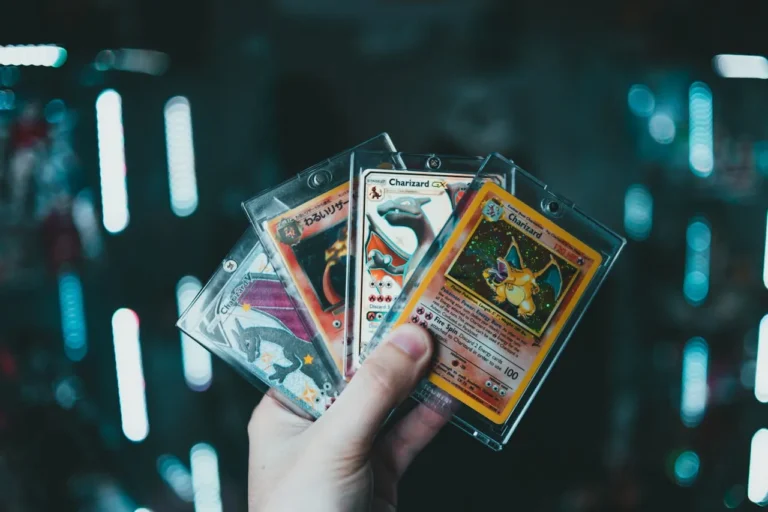Pokémon Cards as a Lucrative Investment
When you were a kid collecting Pokémon cards, you might not have realized you were actually building a potential financial goldmine. These colorful cardboard collectibles have transformed from childhood treasures into serious investment opportunities that can yield substantial returns.
The Remarkable Value of Rare Pokémon Cards
Some Pokémon cards have skyrocketed in market value, with certain rare editions selling for astronomical prices. Professional collectors and investors are now treating these cards like high-value stock investments. A first-edition holographic Charizard card, for instance, can fetch anywhere from $50,000 to over $300,000 depending on its condition.
Factors Determining Card Worth
- Card rarity
- Printing year
- Condition grade
- Limited edition status
- Holographic features
Understanding Card Grading
Professional grading dramatically impacts a card’s value. Companies like PSA (Professional Sports Authenticator) and BGS (Beckett Grading Services) evaluate cards on a scale from 1-10. A perfectly graded card can be worth exponentially more than an ungraded or poorly maintained version.
Grading Impact on Value
| Grade | Potential Value Increase |
|---|---|
| PSA 10 (Gem Mint) | 300-500% higher than ungraded |
| PSA 9 (Mint) | 100-250% higher than ungraded |
Strategic Collection Building
Successful Pokémon card investors aren’t just randomly purchasing cards. They strategically research market trends, track historical prices, and understand which specific cards have investment potential. First-edition sets from the late 1990s and early 2000s are particularly valuable.
Key Investment Strategies
- Focus on sealed, unopened original packs
- Preserve cards in pristine condition
- Research upcoming auction events
- Follow professional collector forums
- Understand generational nostalgia cycles
Modern Market Dynamics
The COVID-19 pandemic unexpectedly boosted Pokémon card values. With people spending more time at home, nostalgic collectors and new investors flooded the market. Online platforms like eBay reported massive spikes in Pokémon card sales, with some rare cards selling for record-breaking prices.
Investment Platforms
Modern investors can now trade Pokémon cards through multiple channels:
- Online auction websites
- Specialized collectible marketplaces
- Professional trading forums
- Cryptocurrency-based trading platforms
Protecting Your Investment
Serious collectors invest in professional storage solutions. Ultra-protective sleeves, humidity-controlled display cases, and professional grading services help maintain a card’s condition and value. Some collectors even purchase insurance for their most valuable pieces.
Preservation Tips
- Use acid-free storage materials
- Control room temperature and humidity
- Avoid direct sunlight exposure
- Handle cards with clean, lint-free gloves
While not every Pokémon card will make you rich, informed collecting can transform this childhood hobby into a legitimate investment strategy. By understanding market trends, prioritizing card condition, and staying informed about collector preferences, you could potentially turn your nostalgic collection into a significant financial asset.
Rare Card Hunting: Strategies for Collectors
Passionate Pokémon card collectors know that finding rare cards isn’t just a hobby—it’s an art form that requires strategy, knowledge, and a keen eye for detail. The world of card collecting is complex and exciting, offering enthusiasts multiple pathways to discover valuable treasures.
Understanding Card Rarity Dynamics
Every serious collector understands that not all cards are created equal. Some cards become astronomical in value due to specific characteristics like limited production runs, printing errors, or unique holographic patterns. First edition cards, particularly from early sets like Base Set, can be worth thousands of dollars if they’re in pristine condition.
Key Factors Determining Card Value
- Mint condition preservation
- Original production year
- Holographic quality
- Printing variations
- Card grading certification
Strategic Collection Approaches
Successful card hunters develop multi-pronged strategies for discovering rare Pokémon cards. Online marketplaces, specialized trading forums, and collector conventions represent prime hunting grounds. Networking with experienced collectors can provide insider knowledge about upcoming releases and hidden gems.
Advanced Collection Techniques
Professional collectors often utilize sophisticated tracking methods. They monitor market trends, follow specific card series, and maintain detailed databases of potential acquisitions. Some enthusiasts use advanced price tracking software to identify undervalued cards before they appreciate in market value.
Authentication and Grading Importance
Professional grading dramatically impacts a card’s potential value. Professional grading services like PSA and BGS provide comprehensive assessments that can exponentially increase a card’s worth. A perfectly graded card can be worth ten times more than an ungraded equivalent.
Grading Scale Insights
| Grade | Condition Description | Potential Value Impact |
|---|---|---|
| PSA 10 | Gem Mint Condition | Highest Potential Value |
| PSA 9 | Near Mint | Significant Value |
| PSA 8 | Near Mint-Mint | Moderate Value |
Investment Considerations
Modern collectors approach Pokémon cards as potential long-term investments. Certain vintage cards have appreciated remarkably, with some first-edition holographic cards fetching six-figure prices at auction. Understanding market trends and maintaining patient collecting strategies can transform a childhood hobby into a serious financial opportunity.
Investment Protection Strategies
- Use professional protective sleeves
- Control humidity and temperature storage
- Avoid direct sunlight exposure
- Handle cards with clean, lint-free gloves
- Consider professional insurance for valuable collections
Digital and Physical Marketplace Navigation
Modern collectors must be adept at navigating both digital and physical marketplaces. Websites like eBay, specialized Pokémon trading platforms, and local collector meetups offer diverse opportunities for rare card acquisition. Understanding pricing algorithms and market fluctuations becomes crucial for making informed purchasing decisions.
The world of Pokémon card collecting continues to evolve, blending nostalgia, investment potential, and passionate community engagement. Whether you’re a casual collector or a serious investor, developing strategic approaches and deep market knowledge can transform your hobby into a potentially lucrative endeavor.
Grading and Valuation: Maximizing Card Worth
When it comes to Pokémon card collecting, understanding the nuanced world of card grading can transform your childhood hobby into a potentially lucrative investment. Professional grading serves as the ultimate authentication and value determination mechanism for collectors and investors alike.
Understanding Card Grading Fundamentals
Professional grading companies like PSA, BGS, and CGC meticulously evaluate cards based on multiple critical factors. These experts examine card condition through comprehensive assessments including:
- Surface quality
- Centering precision
- Corner sharpness
- Edge integrity
- Overall preservation state
A card’s grade significantly impacts its market value. For instance, a pristine PSA 10 “Gem Mint” first-edition Charizard can command astronomical prices compared to lower-graded versions, potentially increasing worth by thousands of dollars.
Maximizing Card Valuation Strategies
Collectors seeking to optimize their Pokémon card investments should consider several strategic approaches:
- Research current market trends
- Understand rarity classifications
- Preserve cards in optimal conditions
- Consider professional grading services
- Track historical price performances
Professional grading provides an objective assessment that removes subjective interpretations. Collectors receive a standardized numerical grade ranging from 1-10, with 10 representing pristine, virtually flawless condition.
Investment Potential Factors
Several key elements influence a Pokémon card’s potential value:
| Factor | Impact on Value |
|---|---|
| First Edition Status | Significantly increases worth |
| Holographic Characteristics | Enhances collectible appeal |
| Historical Significance | Drives collector interest |
Rare cards like the illustrious Pikachu Illustrator, with fewer than 40 known copies, can fetch hundreds of thousands of dollars when professionally graded. This demonstrates the extraordinary potential within strategic card collecting.
Preservation Techniques
Maintaining card condition is paramount for maximizing future value. Recommended preservation methods include:
- Using acid-free protective sleeves
- Storing in temperature-controlled environments
- Avoiding direct sunlight exposure
- Handling cards with clean, lint-free gloves
- Utilizing professional-grade storage cases
Serious collectors invest in professional grading not merely as authentication but as a strategic financial decision. A high-grade card can appreciate exponentially, transforming a childhood collection into a substantial investment portfolio.
Market Dynamics
The Pokémon card market has experienced remarkable growth, with vintage and rare cards seeing unprecedented value increases. Collectors who understand grading nuances position themselves advantageously in this dynamic marketplace. Modern technology and increased collector sophistication have revolutionized card valuation. What was once considered a simple childhood hobby now represents a legitimate alternative investment avenue, attracting serious collectors and financial enthusiasts worldwide. By implementing meticulous grading strategies, preserving card conditions, and staying informed about market trends, collectors can potentially convert their passion into a profitable endeavor. The key lies in education, patience, and strategic decision-making within the evolving Pokémon card ecosystem.
Historical Market Trends in Pokémon Trading
Ever since their introduction in the late 1990s, Pokémon trading cards have experienced fascinating market transformations that reflect both collector passion and significant financial potential. The journey of these colorful cardboard collectibles reveals an intricate landscape of value appreciation and passionate community engagement.
Early Market Dynamics
During the initial release, Pokémon cards were primarily seen as children’s collectibles. The first edition Base Set, launched in 1999, contained cards that would later become incredibly valuable. Rare holographic cards like the first edition Charizard quickly became prized possessions, with early collectors unknowingly preserving potential future investments.
Generational Value Shifts
As the original Pokémon generation aged, nostalgia became a powerful market driver. Collectors who grew up with these cards started investing substantial money into acquiring rare specimens. This emotional connection transformed the market from a children’s hobby to a serious collector’s investment platform.
Rarity and Condition Factors
Several critical factors influence a Pokémon card’s market value:
- Card condition (mint, near-mint, played)
- First edition prints
- Holographic variations
- Limited production runs
- Professional grading certifications
Market Valuation Trends
The market has witnessed exponential growth. A first edition Charizard card that originally cost less than $10 can now command prices exceeding $300,000 in pristine condition. Professional grading services like PSA have become crucial in authenticating and valuing these collectibles.
Investment Performance
Comparative data demonstrates remarkable investment potential:
| Card Type | 1999 Price | 2023 Estimated Value |
|---|---|---|
| First Edition Charizard | $5-$10 | $300,000+ |
| Pikachu Illustrator | N/A | $5,000,000+ |
Modern Collecting Landscape
Digital platforms and online marketplaces have revolutionized trading. Websites like eBay and specialized collector forums have created global marketplace accessibility, enabling collectors worldwide to buy, sell, and trade rare Pokémon cards with unprecedented ease.
Authentication and Preservation
Modern collectors invest significantly in card preservation. Professional grading, protective sleeves, and climate-controlled storage have become standard practices. These methods ensure long-term value maintenance and protect against potential degradation.
Emerging Market Segments
Recent years have seen diversification within Pokémon card collecting:
- Competitive tournament card collectors
- Vintage collection specialists
- Investment-focused collectors
- Thematic set completionists
Future Projection
Expert analysts predict continued market growth. With increasing global recognition and generational nostalgia, Pokémon cards represent more than mere collectibles—they’re tangible memories with substantial financial potential. The Pokémon card market has transformed from a childhood pastime into a sophisticated collecting ecosystem. Whether driven by nostalgia, investment potential, or pure passion, these small pieces of cardboard continue to captivate collectors worldwide, proving that some childhood hobbies truly can become remarkable financial opportunities.

Investment vs. Passion: Understanding Card Collecting Economics
Collecting Pokémon cards isn’t just a nostalgic pastime anymore—it’s a serious financial opportunity that blends childhood memories with sophisticated investment strategies. What started as a simple trading card game has transformed into a multi-million dollar market where rare cards can fetch astronomical prices.
The Financial Landscape of Pokémon Card Collecting
Seasoned collectors understand that Pokémon cards represent more than just colorful pieces of cardboard. These small collectibles can appreciate significantly in value, with some rare cards selling for hundreds of thousands of dollars. Take, for instance, the First Edition Charizard card, which has sold for over $300,000 in pristine condition.
Market Dynamics and Value Determination
Several critical factors influence a Pokémon card’s potential investment value:
- Card Condition (Grading)
- Rarity of the Specific Edition
- Historical Significance
- Demand from Collectors and Investors
Understanding Card Grading
Professional grading services like PSA (Professional Sports Authenticator) play a crucial role in determining a card’s market value. A card graded as a perfect 10 can be worth exponentially more than an ungraded or lower-grade version of the same card.
Investment Strategies for Pokémon Card Collectors
Successful Pokémon card investors don’t just randomly purchase cards. They develop strategic approaches that involve:
- Researching Historical Price Trends
- Understanding Generational Nostalgia Cycles
- Tracking Limited Edition Releases
- Maintaining Proper Card Storage Conditions
The Role of Nostalgia in Card Value
Interestingly, nostalgia drives a significant portion of the Pokémon card market. Millennials who grew up with the franchise are now adults with disposable income, willing to invest substantial amounts to recapture childhood memories.
Risk Management in Card Collecting
While the potential for high returns exists, collectors must approach the market with calculated strategies. Not every card will appreciate in value, and market fluctuations can be unpredictable. Diversification and thorough research are key to mitigating potential financial risks.
Emerging Market Trends
Digital platforms and online marketplaces have revolutionized Pokémon card trading. Websites and apps now provide real-time pricing data, authentication services, and global marketplaces that were unimaginable two decades ago.
Financial Education Through Collecting
For younger collectors, Pokémon card investing offers an unexpected avenue for learning financial literacy. Tracking market trends, understanding value appreciation, and making informed purchasing decisions are valuable skills that extend far beyond the world of trading cards.
Long-Term Investment Perspective
Serious collectors view their collections as potential long-term investments. Some rare cards have shown consistent appreciation rates that rival traditional investment vehicles. However, patience and strategic selection are paramount to success.
Whether you’re a passionate fan or a strategic investor, Pokémon card collecting offers a unique intersection of emotional connection and financial opportunity. By understanding market dynamics, maintaining card conditions, and staying informed about trends, collectors can transform a childhood hobby into a potentially lucrative investment strategy.
Conclusion
The world of Pokémon card collecting has transformed from a childhood pastime into a sophisticated investment landscape that offers remarkable financial opportunities. Whether you’re a nostalgic collector or a strategic investor, the Pokémon card market provides a unique blend of passion and potential profitability.
Smart collectors understand that success isn’t just about luck—it’s about knowledge, patience, and strategic decision-making. By mastering grading techniques, tracking market trends, and understanding the nuanced economics of card collecting, enthusiasts can turn their hobby into a potentially lucrative venture.
The key is to approach Pokémon card collecting as both an art and a science. Research, preservation, and timing are critical factors that separate casual collectors from serious investors. Rare cards like first-edition holographics or pristine vintage sets can appreciate dramatically, sometimes reaching six or seven-figure valuations.
While the market fluctuates, the emotional and financial rewards remain significant. Collectors who combine their childhood passion with informed investment strategies can build impressive portfolios. The most successful investors view their collection as a balanced investment—part emotional connection, part financial asset.
Your journey in Pokémon card collecting doesn’t have to be about massive profits. It can be a fulfilling hobby that potentially generates substantial returns. By staying informed, maintaining card conditions, and understanding market dynamics, you can transform those childhood memories into a meaningful financial opportunity.
Remember, every rare card tells a story—and in this market, those stories can be worth more than you ever imagined.
Read Also BRICS Investing—The Global Wealth Shift You Can’t Afford To Ignore!
Was this helpful?




Leave Feedback